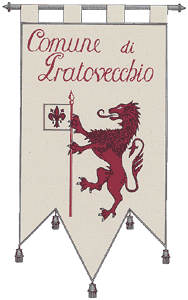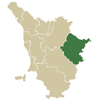|
 Inhabitants in 1991 : 3,068
Inhabitants in 1991 : 3,068
 The Municipal territory of Pratovecchio in Casentino, extends for 75,48
square kilometres from the ridge of the Tosco-Romagnolo Apennines
to the valley bottom crossed by the Arno and rising almost to the Pass
della Consuma. Feudal centre, became the Podesta Seat of Office,
deprived of the district of Stia in 1872, it constituted itself in autonomous
community, and in 1929 the community of Pratovecchio was suppressed
and became part of the community of Pratovecchio-Stia. It assumed its
present day aspect in 1934 when it was re-constituted as the original
community with the surrender to Stia of the districts of Papiano
and Ponte d’Arno and with the aggregation by Stia of the
zone between the river Arno, the channels of Vicena and Asinaia and the
Firenze province borders.
The Municipal territory of Pratovecchio in Casentino, extends for 75,48
square kilometres from the ridge of the Tosco-Romagnolo Apennines
to the valley bottom crossed by the Arno and rising almost to the Pass
della Consuma. Feudal centre, became the Podesta Seat of Office,
deprived of the district of Stia in 1872, it constituted itself in autonomous
community, and in 1929 the community of Pratovecchio was suppressed
and became part of the community of Pratovecchio-Stia. It assumed its
present day aspect in 1934 when it was re-constituted as the original
community with the surrender to Stia of the districts of Papiano
and Ponte d’Arno and with the aggregation by Stia of the
zone between the river Arno, the channels of Vicena and Asinaia and the
Firenze province borders.
Pratovecchio had been feudal to the Counts Guidi da Battifolle
since the XII century, as a result of a privilege by Arrigo VI in
1191, although, already more than a century earlier a Monastery of
Pratovecchio was recorded around which the Castle was developed.
In the first half of the XIV century, as ascertained in certain
documents, it belonged to a branch of the Guidi di Dovadola
who surrounded it with walls and channels ; but at least from
1367 it had returned, supposedly under the trust of the Fiorentina
republic, in the possession of the Guidi di Poppi, who followed
their destiny until 1440, when Count Francesco was forced to abandon
Poppi and the Casentino. Pratovecchio, became part of the Fiorentino territory
and declared Podesta Seat of Office. Born in this territory were
Paolo di Dono called Paolo Uccello, the great artist of the first
Fiorentina renaissance (1397-1475), Cristoforo Landino (1424-1498),
erudite humanist noted as annotator of the Divina Commedia, and
Iacopo Landini called Iacopo del Casentino (1297-1358) artist.
Close to the capital and overlooking it, are the ruins of the Castle
of Romena, where the Alighieri lived in exile, guest of Count Guido
Selvatico da Dovadola.
|
Places to visit :
Parish Church, erected in Piazza Landino, hosts two precious
1600 paintings, adjacent is the Closed Convent of the Camaldolesi
Nuns, founded by the Counts Guidi in the XII century. Also in
the vicinity of Piazza Landino is the 1500 Closed Monastery of
the Domenicane Monks.
Maria a Poppiena. single nave church hosting works of art.
|
Historical info reproduced upon authorization of Regione Toscana - Dipartimento della Presidenza E Affari Legislativi e Giuridici
Translated by Ann Mountford
|